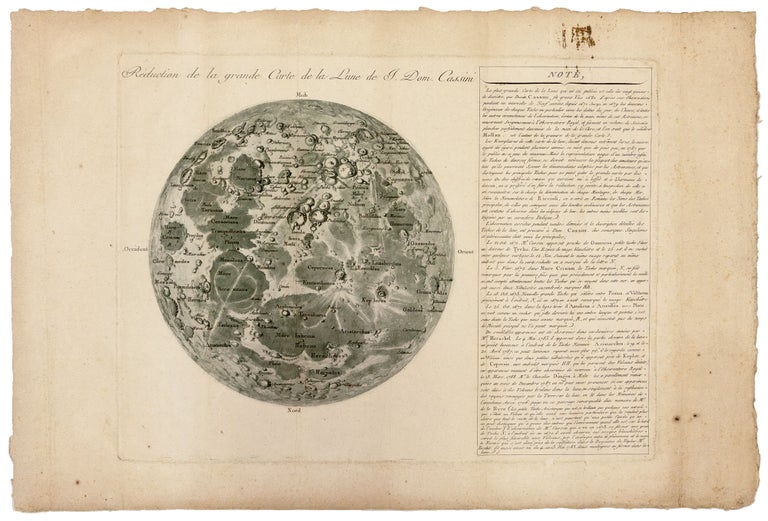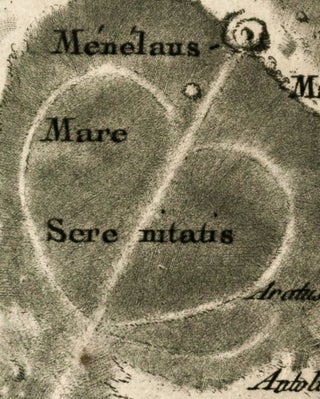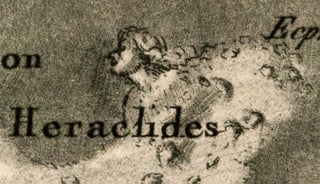Réduction de la grande Carte de la Lune de J. Dom. Cassini.
[43.3 x 28.6 the sheet], [31.3 x 23.6 cm the platemark]. Ample margins, a fine strike, with color well preserved, some dustiness and soiling to top right and right margins, lightly toned.
Very rare first and only edition of this separately issued ‘petite’ lunar map published in 1788 by Jean-Dominique Cassini (1748-1845) updating with explanatory text for a more general audience the groundbreaking 1679 map of his famous great-grandfather, Giovanni Domenico Cassini (1625-1712).
In 1787, Jean-Dominique Cassini – today known to scholars as Cassini IV – rediscovered in the Royal Observatory the original copperplate of his great-grandfather Giovanni Domenico’s (i.e., Cassini I’s) grande carte and reprinted it in a limited edition. The following year, he then produced the present Réduction de la grande Carte de la Lune, aiming to bring these earlier maps up to date by labeling the lunar surface and adding a sidebar of notes regarding recent scientific discoveries, most prominently the recent observations of Sir William Herschel (1738-1822) and Chevalier Jean Auguste d’Angos (1744-1833). The Réduction de la grande Carte de la Lune, as he titled it, thus both links four generations of astronomers from the Cassini family and explicates one of the most significant (and fanciful) images of 17th-century lunar astronomy according to the scientific standards prevalent just before the turn of 19th century.
The Réduction is distinguished from the grande carte not only by its smaller format, but also by its new labels describing the moon’s surface features and by the addition of a running text that both explains the wider history of the map and presents what Cassini IV calls “curious observations that had never before been published” (Mémoires, p. 340). In this text Cassini IV laments that the 1679 map – first printings of which had become “extrement rares” – was of limited use to most astronomy enthusiasts (amateurs): the grande carte offered “a broad representation of a very great number of lunar features (taches),” but this level of detail was wasted on those observing the moon through all but the most powerful telescopes. Furthermore, the grande carte was entirely devoid of labeling or other text, and modern appreciation of the moon required a precise understanding of lunar nomenclature. The Réduction thus labels some 130 lunar features according to the terminology devised by Giovanni Battista Riccoli (1598-1671), marking more prominent “mountains and seas” with place-names engraved in Roman letters and less visible features in italic letters. (Cassini IV dared not mar the original grande carte copperplate through re-engraving it with added text).
The gray-green image of the moon was executed en manière de lavis (a forerunner of the aquatint technique) by “le plus fameux artiste en ce genre,” the renowned printmaker Jean-François Janinet (1752-1814; Histoire, p. 34). Known for his ancien régime prints in the mode of Jean Honoré Fragonard and Jean-Baptiste Greuze (and later, engravings on Revolutionary politics), Janinet preserves in the Réduction one of the more fanciful features of the grande carte (and indeed of all modern lunar imagery): the so-called Lady in the Moon. This Moon Maiden, a beautiful woman in profile with her long hair trailing behind her, appears at the Hericlides promontory at the bottom right of the image. Recent scholarship posits that this (decidedly unscientific) insertion is a portrait of Cassini I’s future wife, Genèvieve de Laistre, and it stands to reason that Cassini IV would preserve this enigmatic image of his great-grandmother even as he modernized other aspects of the map (see esp. the articles of Launay). Another odd marking, shaped like the Greek letter phi (φ), appears in the Sea of Serenity. Shaped like a heart, this letter also begins the Greek word philos, meaning love or affection. (The account books from the Observatory record that the Réduction was published in 364 copies, tantalizingly close to a symbolic reference to the number of days in a calendar year [Launay, p. 16]).
Jean-Dominique Cassini (Cassini IV) was born at the observatory in Paris which his great-grandfather had founded. Cassini I studied at the Panzano Observatory under G. B. Riccioli and Francesco Maria Grimaldi. In 1669 he moved to France on the invitation of Jean-Baptiste Colbert to become the first director of the Paris Observatory. Using a 34-foot telescope by the great instrument maker Giuseppe Campani, Cassini made some 60 drawings of the moon between 1671 and 1679, with the assistance of the artists Sebastien Leclerc and Jean Patigny. Many of his observations were made during lunar eclipses, which provided atypical lighting and a clearer view of the moon’s surface. The copperplate for the map was created from these drawings by the celebrated printmaker Claude Mellan. The fine renderings of lunar features by Patigny and Mellan remained unsurpassed until the advent of photography. Cassini IV succeeded his father, Casini III and grandfather Cassini II, as director of the Paris Observatory in 1784. After the French Revolution in 1789, friction between Cassini IV and the National Assembly caused him to resign his post as Director. He was briefly imprisoned before retiring to Thury, where he lived and worked for the rest of his life.
OCLC locates no copies of this print in U. S. institutions. The 1679 grande carte is held only at the Ransom Center, Texas, and has appeared at public auction only once in recent memory (2014, Christie’s, 103,500 Euros). OCLC does not locate the 1787 second edition of the grande carte, originally printed in only 100 copies, in any U. S. institutions.
* J.-D. Cassini, Mémoires pour server a l’histoire des sciences et a celle de l’Observatoire Royal de Paris (1810), p. 340; Histoire de l’Académie Royale des Science. Année M. DCCLXXXVII. (1789), p. 34; Françoise Launay, ‘The moon maiden of Cassini’s map’, Astronomy and Geophysics 44 (2003); Launay, ‘La tête de femme de la carte de la lune de Cassini. Une déclaration d’amour’, L’Astronomie 117 (2003),pp. 10-17; C. Wolf, Histoire de l’Observatoire de Paris de sa fondation à 1793, pp. 169-71; S. L. Montgomery, The Moon and the Western Imagination; T. Weimer, ‘Carte de la Lune de J.D. Cassini’, The Moon and the Planets 20 (1979), pp.163-167; E. A. Whitaker, Mapping and Naming the Moon. pp. 78-9; Whitaker, “Selenography in the Seventeenth Century,” in R. Taton and C. Wilson (eds.), Planetary Astronomy from the Renaissance to the Rise of Astrophysics; A. van Helden, ‘The Telescope in the Seventeenth Century’, ISIS 65 (1974); H. Kragh, The Moon that Wasn’t.
Sold



